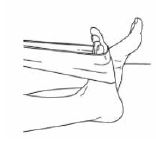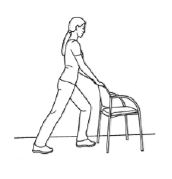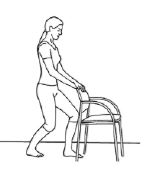The aim of this advice is to give you some understanding of the problems you have with your heel and to provide some advice on how to manage this. It is not a substitute for professional healthcare advice and should be used along with information you may be given by your GP or Allied Health Professional.
The Plantar Fascia
The plantar fascia is a thick, broad inelastic band of fibrous tissue that runs along the bottom (plantar surface) of the foot. It is attached to the heel bone (calcaneus) and fans out to attach to the bottom of the metatarsal bones at the ball of the foot. The plantar fascia acts like a bowstring to maintain the normal arch of the foot.
What is Plantar Fasciitis?
Plantar fasciitis is a painful inflammatory condition caused by either injury or excessive wear to the plantar fascia. The pain usually is felt on the underside of the heel and is often most intense with the first steps of the day.
Symptoms
- Pain whilst standing or walking.
- Tenderness around the base of the heel.
- Stiffness in the ankle and calf muscles.
- The pain is often most intense with the first steps of the day.
Treatment
Stretches and strengthening exercises can help relieve your pain and restore function.
Other physiotherapy treatment options may include the use of ice, ultrasound, acupuncture, deep tissue massage and taping. The use of insoles may also be discussed to help provide pain relief.
The most common stretches are included on the sheet provided; however your physiotherapist may show you more specific exercises to strengthen the small muscles in your foot if indicated.
A steroid injection into your plantar fascia is sometimes offered by your GP should you fail to respond to physiotherapy intervention.
Exercises
All exercises should be relatively comfortable to do. If you have pain on a specific exercise that does not settle quickly, you should stop that exercise.
 Exercise 1
Exercise 1
Use a towel wrapped around the ball of your foot and pull your foot towards you until you feel a stretch.
 Exercise 2
Exercise 2
Stand with affected leg behind the other leg, keeping the heel down on the floor and the knee straight.
Lean forward bending the front knee forward until you feel a stretch in your calf and Achilles tendon. Hold 20 seconds and repeat 3 times
 Exercise 3
Exercise 3
Repeat as exercise 3 but with knee of affected leg slightly bent.
Medication
Many people use medication to help them remain active and to cope with their pain and symptoms. It is recommended that you take your medication regularly. It is best to get advice from a GP or pharmacist.
Other Intervention
There are other health interventions which may be more appropriate for your condition. These can be discussed with your health care practitioner.
Work
It is usually recommended that you try to stay at work or get back to work as soon as possible. You do not need to be fully pain and symptom free to return to work.
Research shows the longer you are off work the less likely it is that you return.
Investigations/Do I Need Any Special Tests
The main way we diagnose your Plantar fasciitis is through what you tell us and by examining your heel and foot. Other investigations may be considered, these can be discussed with your health care professional.
Try to stay positive. There is a lot you can do to help yourself. Most symptoms do settle with time.

